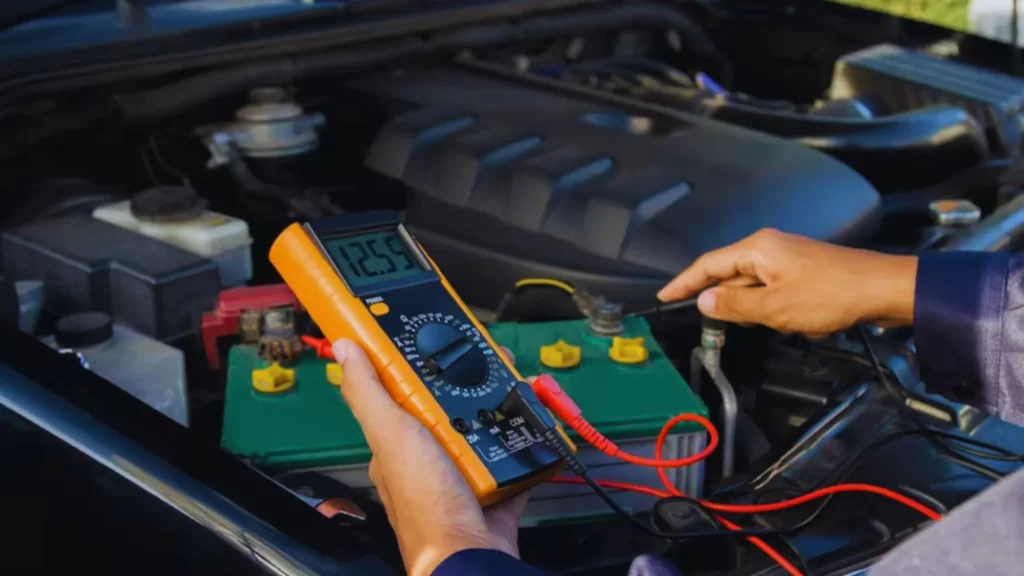It’s not just batteries that die in cars. It’ll happen if you leave it long enough. A few hours or even a day or two will not suffice. Having a dead battery after your car has been parked, despite running fine, indicates something is broken, if not a switch that you didn’t even know was on.
The problem is that something is drawing power from the battery when it shouldn’t. There are a million reasons why that might be, and a parasitic draw test can help you pinpoint the problem, allowing you to find a solution quickly. However, you will have to do some detective work along with it, but it’s still an effective troubleshooting technique. To understand how to do a parasitic draw test, you need to understand its basic function first.
What Is Parasitic Draw?
When a vehicle’s ignition is turned off, parasitic draw, also called parasitic current or electrical drain, drains the battery. Certain electrical components in the car continue to draw power even when the engine is not running. Additionally, clocks, alarms, infotainment systems, and electrical circuits can malfunction. A drained battery can cause frustrating situations when your vehicle is unable to start due to gradual battery degradation.

Why It’s Essential To Diagnose And Fix Parasitic Draw
Parasitic draw must be diagnosed and corrected for several reasons. Firstly, it prevents car battery failures that can leave you stranded, especially in inconvenient places. If parasitic draw issues are fixed, your vehicle’s battery will last longer, saving you money on battery replacements. Additionally, treating parasitic draw consistently reduces the risk of electrical failures and improves your vehicle’s safety and reliability by ensuring the overall health of its electrical system. In order to avoid unnecessary inconveniences, expenses, and safety hazards, parasitic draw should be diagnosed and addressed during vehicle maintenance.
Read More About: Best Multimeter For RV Testing
Necessary Tools and Equipment
- Digital Multimeter
- Wrenches and Sockets
- Protective Gear
- Battery Charger or Jump Starter
- Fuses and Fuse Puller
- Work Light or Flashlight
- OBD-II Scanner (optional)

How To Do A Parasitic Draw Test With Multimeter?
The parasitic draw test can easily be performed with a multimeter. You need to measure the battery’s initial voltage with a multimeter first. Follow these steps:
Initial voltage measurement
You should measure the voltage before measuring the amperage of the battery to ensure its overall health.
Step#1 Prepare your digital multimeter: Put your digital multimeter in DC voltage mode. By measuring voltage across the terminals of the battery, this mode can be used.
Step#2 Connect the multimeter leads: Turn off the ignition and make sure no accessories are plugged in. The positive (red) lead of the multimeter should be connected to the positive terminal of the battery, and the negative (black) lead to the negative terminal.

Step#3 Observe the voltage reading: Connect the multimeter to the terminals of the battery and observe the voltage reading. The voltage of a healthy battery should be around 12.6 volts. A reading below this can indicate a weak or discharged battery, which may need charging or replacement.
Step#4 Interpret the results: A reading that is significantly lower may indicate a problem with the battery that requires attention before the parasitic draw test can be performed.
Read More About: Best Low Current Clamp Meter
Under the hood, Find the fuse block

Now that we know a draw exists, the next step is to locate it. Locate the fuse block under the hood.
Read more about How To Check Car Fuses With a Multimeter?
Step#1 Insert probes and clamp them

It’s now time to free yourself from the multimeter and battery. To keep your leads in place if you don’t have a helper, use alligator clamps or clamp-type leads, then position the multimeter so it’s easily visible from the fuse box.
Step#2 Pull Fuses

When you’ve got the multimeter in position, begin pulling fuses and replacing them one by one. A circuit that’s giving you trouble may have an amperage drop when the fuse is pulled.
Step#3 Disconnect and Locate the Next Fuse Block
There is a good chance that the problem won’t be associated with the first fuse box you test. Then you move on to the next. You can damage the multimeter by opening and closing doors while it is connected to the battery, so disconnect the meter before doing so. You put your equipment at risk when your lights turn on because the sudden load drains your battery.
Step#4 For parasitic draw testing, the door latch should be closed

It may be necessary to move the door latches to the closed position in order to prevent the dome light from drawing power.
Step#5 Switch off the lights and put the car to sleep
On older cars, you can keep the pressure switch depressed with a clamp or tape by opening the door. Modern cars aren’t as simple as their predecessors. To put the car to sleep, you may need to open all the doors and switch the latches to the closed position, then electronically lock the doors.
Step#6 Repeat until the circuit is located that is affected
Pull the fuse until you find the trouble circuit after you figure out the door/light situation.
Read More About: How to Test Current Draw with a Multimeter?
Locating the Source of Parasitic Draw
Locating the source of the parasitic draw gives you complete help with which component is responsible for the parasitic draw.

Analyzing the test results
The parasitic draw test results should be carefully analyzed following the measurement of the amperage. Amperage readings can be used to determine how much parasitic draw your battery has. Check your car’s repair manual for amperage limits, or compare them to your vehicle’s specifications. If the measured amperage significantly exceeds the threshold, it indicates a parasitic draw problem.
Narrow down the issue
Identifying parasitic draws requires systematic and organized approaches. Identify the electrical components and circuits in your vehicle. Circuit breakers or fuses can be removed and then reinstalled one at a time with a fuse puller or circuit breaker. As you do this, pay close attention to any substantial drops in amperage on your multimeter. When such drops are present, it is a strong indication that the responsible circuit or component has been identified. Repeat this procedure until you have identified the specific electrical circuit or component causing the excessive draw.
Inspecting common culprits (interior lights, alarms, audio systems, etc.)
In certain vehicle components, parasitic draws are common. Inspect interior lights, trunk lights, and aftermarket alarms or audio systems, which are known to be common culprits. Disconnect or temporarily disable these components if necessary to determine whether they are causing the excessive current drain. This targeted inspection will allow you to eliminate these common suspects or confirm their involvement in parasitic draws.
Identifying the circuit with excessive draw
If you narrow down the potential causes of the parasitic draw, you can identify the specific electrical circuit or component that is causing the excessive draw. Additional testing, wiring inspection, or component disconnections may be necessary. Note any noticeable changes in your multimeter’s amperage reading during these steps. Your path to finding the parasitic draw begins when the amperage drops significantly. Once you find the source of the problem, you can repair or replace it, thereby resolving the issue and restoring your vehicle’s electrical system. When you want to know how to do a parasitic draw test, you should take safety precautions.
Safety Precautions For A Parasitic Draw Test

Identifying unwanted battery drain in your vehicle requires a parasitic draw test. This test can be a helpful diagnostic tool, but it’s important to prioritize safety when performing it to prevent any potential risks. Here are some safety precautions to keep in mind:
1. Protective Gear
It is important to have the necessary protective gear before starting a parasitic draw test. Protect your eyes from sparks and debris by wearing safety glasses. Handling electrical components can also be protected by wearing gloves.
2. Disconnect the Vehicle Battery
It is always a good idea to start by disconnecting the vehicle’s battery. In this way, potential short circuits and electrical shocks are prevented during the test. Disconnect the negative terminal first, then the positive terminal. To avoid accidental reconnection, keep the battery cables away from the battery posts.
3. Use a Digital Multimeter
Use a digital multimeter (DMM) for accurate and safe testing. Because analog multimeters rely on a moving needle, they can be less precise and pose a greater risk. Maintain your DMM’s calibration and ensure that it is in good working order.

4. Work in a Well-Ventilated Area
Tests should be performed in an area that is well ventilated, preferably outdoors. In this way, any fumes or gases released during the test can be dispersed. Batteries in many vehicles today are maintenance-free, but some older models emit gases that can be harmful if exposed to open sparks.
5. Exercise Caution with Vehicle Electronics
Working around a vehicle’s electrical components, especially airbags, can be dangerous if they are accidentally deployed. Make sure you are aware of the specific locations of critical vehicle electronics, and avoid touching wires and connectors.
6. Properly Label and Document Connections
Label and document the positions of components while disconnecting and reconnecting them during the test to avoid confusion. It is especially important when removing fuses, relays, or wires.
Read More About: Fluke 83V Industrial Digital Multimeter
Conclusion
Multimeters are versatile tools for testing electrical components. In case you have a multimeter, don’t worry about how to do a parasitic draw test. Safety should always be a priority before the test begins. Safety is not taken seriously by some people, and as a result, they experience some shocks or damage electrical components.
